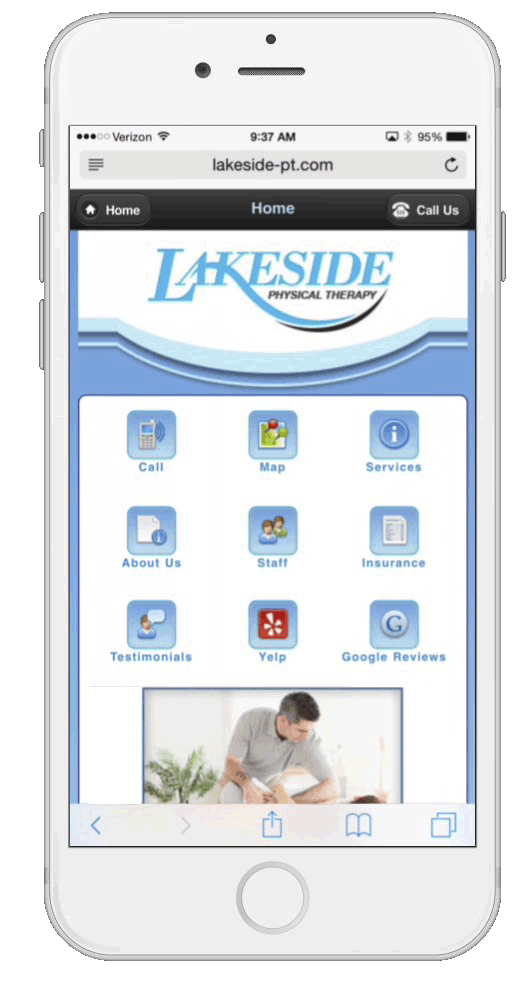 Thought leaders in the PT industry point to business differentiators like company culture, clinical excellence, and customer service, as means to establish long-term competitive advantages.
Thought leaders in the PT industry point to business differentiators like company culture, clinical excellence, and customer service, as means to establish long-term competitive advantages.
One online opportunity that is untapped by most private practices and will go a long way to improve your customer service, is mobile marketing. Mobile marketing can be defined as “using interactive wireless media to provide customers with time and location sensitive, personalized information that promotes goods, services and ideas, thereby generating value for all stakeholders”.1
Consider these facts about how people and patients use search engines, ratings & reviews, and mobile devices:
- 73% of all Americans used search engines.2
- 83% of search users say Google is their search engine of choice.2
- 19% consult rankings/reviews of health providers.3
- 35+% use mobile phone for health info.3
- Smartphones are owned by 42% of U.S. consumers.4
- 91% of all U.S. citizens have their mobile device within reach 24/7.5
- 16% of visitors to PT private practice websites are using a mobile device.6
Eight Ways to Set Your Practice Apart with Mobile Marketing
When developing a marketing strategy to differentiate your practice, you of course should consider the behaviors of the patient populations you serve. Given the facts above, here are some recommendations for your mobile marketing initiative:
1. Have a mobile version of your website served to those that visit your website on a mobile device. It will load much faster than the desktop version of your website. Include features like:
a. A “tap to call button”,
b. Location information that is integrated with the smartphone’s mapping application (which in most cases is Apple Maps or Google Maps) and,
c. An electronic appointment request.
2. Make sure you are listed in Google Maps (aka Google Places) when patients do a search for physical therapy in your city. This may require Local Optimization which is distinctly different from search engine optimization. Have you ever heard this from a patient? “My doctor told me to find a physical therapist that is close to me.” When physicians make this kind of referral statement, and given consumers’ propensity to use their smartphones and Google, being listed in local business listings like Google Maps (Google Places) can generate more referrals.
3. Create a mobile page with links to your directory ratings and review pages. Ratings and reviews are becoming more popular and patients are giving them more weight when making buying decisions. However, it is tedious to get patients to visit your ratings and review pages. Create a simple paper handout to direct patients to your business ratings and review websites like Google, Yelp and Yahoo Local. Better yet, make those ratings and review pages easily accessible on your practice’s mobile website.
4. Create a mobile optimized form for appointment requests. Make sure you share this opportunity to request an appointment online with your patients on their first visit. You will be surprised how many patients enjoy this convenience. Also, make sure that there is someone in your office that has the dedicated task of monitoring online appointment requests.
5. Link to your social network pages. Social networking sites like Facebook and Twitter are good ways to stay engaged with your current and past patients. One problem is getting patients to “Like” your Facebook Page or follow you on Twitter. Include your social networking sites in your mobile website so you can quickly direct them to your social network.
6. Make them and offer. Prospective patients that visit your website with a mobile device are more likely to be looking for your services. Consider offering a free screening, perhaps over the phone, to encourage people to choose your practice.
7. Use QR codes. QR codes are simply two dimensional bar codes that hold information. When scanned, they can provide the viewer with different data types such as a web address, YouTube video, Google Map location, Facebook page address, plain text, an SMS message, email message, and more. Think about putting a QR code on your business card, your referral sheet, your marketing collateral, on a patient invoice that directs them to your online payment page. There are many possibilities. Of course, QR codes are only useful to people with smartphones that have a QR reader installed. That number is increasing though.
8. Use SMS (text) messaging for appointment reminders. Text message appointment reminders are another customer service opportunity that could significantly impact your arrival rate. Given that 97% of text messages are opened, sending appointment reminders to mobile devices can be an attractive option to cut cancelation rates. 7 Remember that text messaging is not secure so you should avoid mentioning physical therapy and your business name in the message. The message might state, “Reminder, you have an appointment tomorrow at 1:30 PM.” Some simple instruction that a text message is coming as a reminder is likely to be good enough for most patients.
In summary, mobile marketing is a great way to improve:
- The patient experience,
- Your local online reputation,
- Your search results,
- Cut down on your cancellation rate.
For the DIY Therapist Here’s a Checklist – Click Here
Mobile marketing can be a DIY project. However, it’s going to be a much better investment of your time and money if you find a service provider to assist you especially if they have knowledge of the physical therapy market. Your time is better spent treating patients than trying to figure up how to build a mobile marketing platform.
- Wikipedia.org. Mobile Marketing. Available at: https://en.wikipedia.org/wiki/Mobile_marketing .Accessed March 23, 2012.
- Purcell, K., et. al. Search Engine Use 2012. Pew Internet & American Life Project. Available at: https://www.pewinternet.org/Reports/2012/Search-Engine-Use-2012/Summary-of-findings.aspx . Accessed March 9, 2012.
- Rainie, L. The Rise of the e-Patient, Jan 12, 2012. Pew Internet & American Life Project.Available at: https://pewinternet.org/Presentations/2012/Jan/The-Rise-of-the-ePatient.aspx Accessed March 23, 2012.
- Smith, A. Smartphone Adoption and Usage July, 2011. Pew Internet & American Life Project.Available at: https://pewinternet.org/Reports/2011/Smartphones/Section-1.aspx . Accessed March 23, 2012.
- Hopkins, J. 9 Amazing Mobile Marketing Statistics Every Marketer Should Know. Hubspot Blog. Available at: https://bit.ly/p0dHCY . Accessed February 1, 2012.
- Straight, D. E-rehab.com – March, 2012. Based on random sample of 20 website statistics over 90 day period.
- Cohen, M. Text Message Marketing. NY Times. September 23, 2009. Available at https://nyti.ms/1E6J5k . Accessed January 17, 2012.


Leave a Reply
You must be logged in to post a comment.